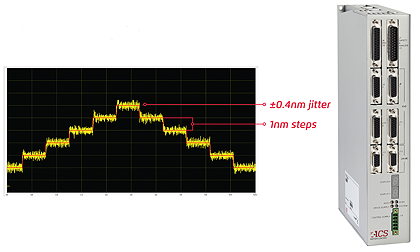When used with an optional 10MHz laser encoder interface and ACS’ ServoBoost control algorithm, they can achieve positioning speeds above 2m/s, sub-nanometer jitter values, nanometer velocity tracking errors, low settling times, with minimal sensitivity to disturbances and load changes.
“The NPMPM Series is specifically designed to address the most demanding applications with regards to move and settle times, standstill jitter and velocity smoothness,” says ACS president, Ze'ev Kirshenboim. He reports that the drives have been tested recently by the Fraunhofer Institute for Production Technology in Germany and achieved standstill jitter and step response results better than any other drives that the Institute has tested.
The NPMPM drives run as slaves under any ACS EtherCat master. They have already been tested in demanding applications such as wafer metrology and inspection, and ultra-precision machining for processing of optical components.

ACS' dual-axis servodrive module (right) achieves extremely low levels of standstill jitter
The drives operate from 12–100V DC and deliver up to 13.3A continuous (40A peak).
They have four digital inputs for registration marks as well as two general-purpose digital inputs. There are four 12-bit analogue inputs and four 16-bit analogue outputs, in addition to two digital position event generators and two general-purpose digital outputs. STO (Safe Torque Off) is an option.

